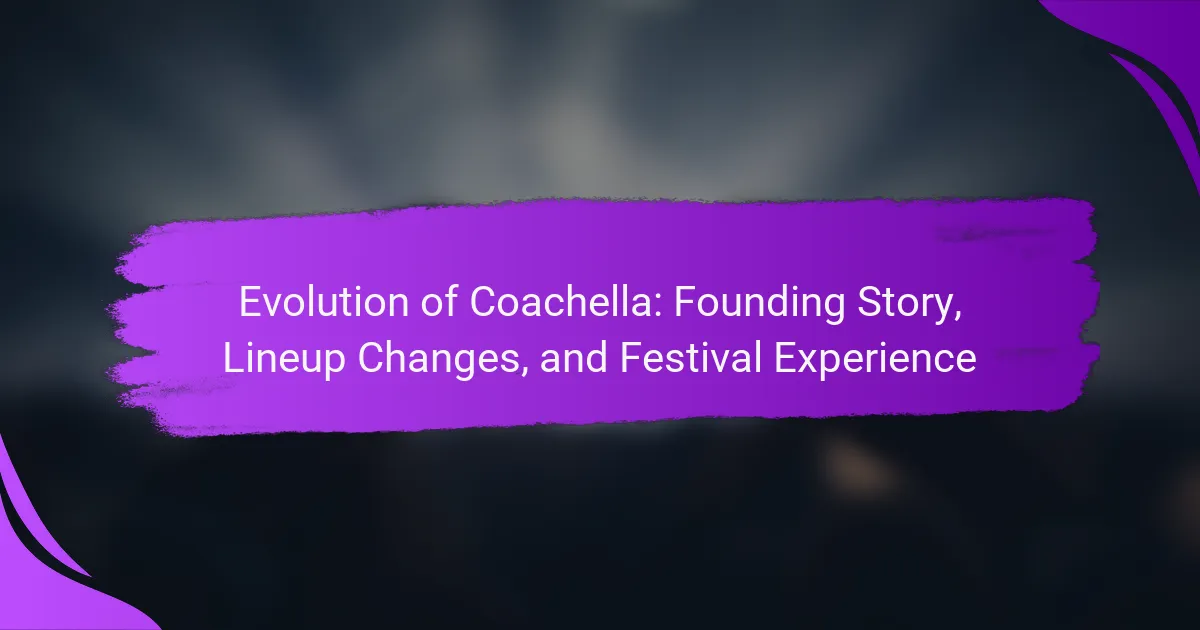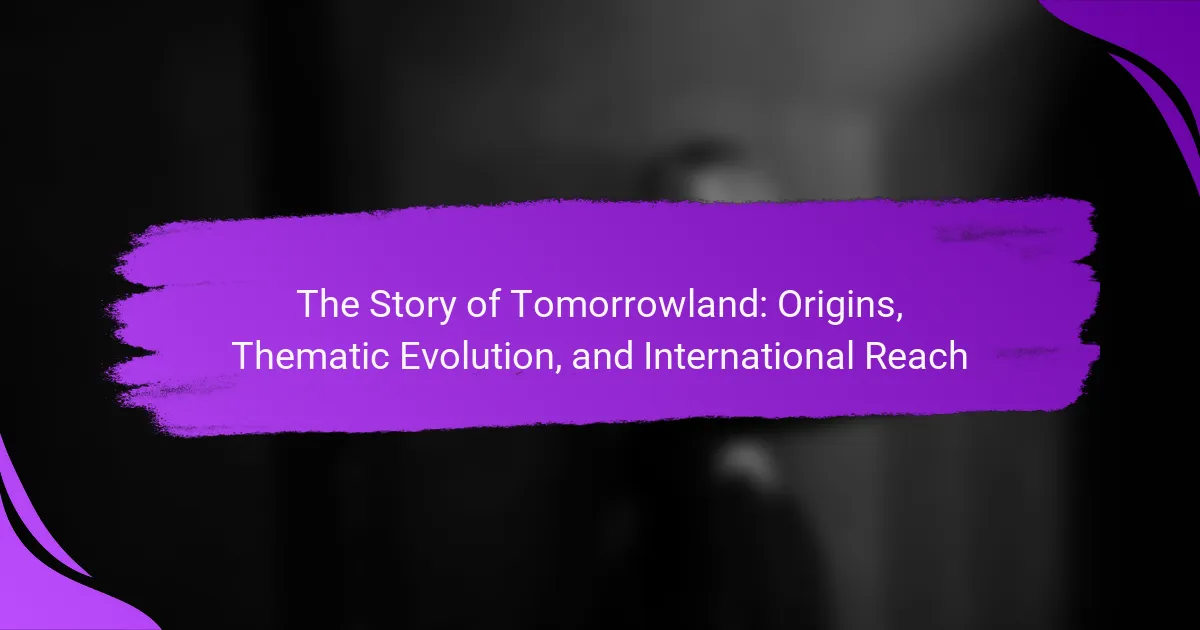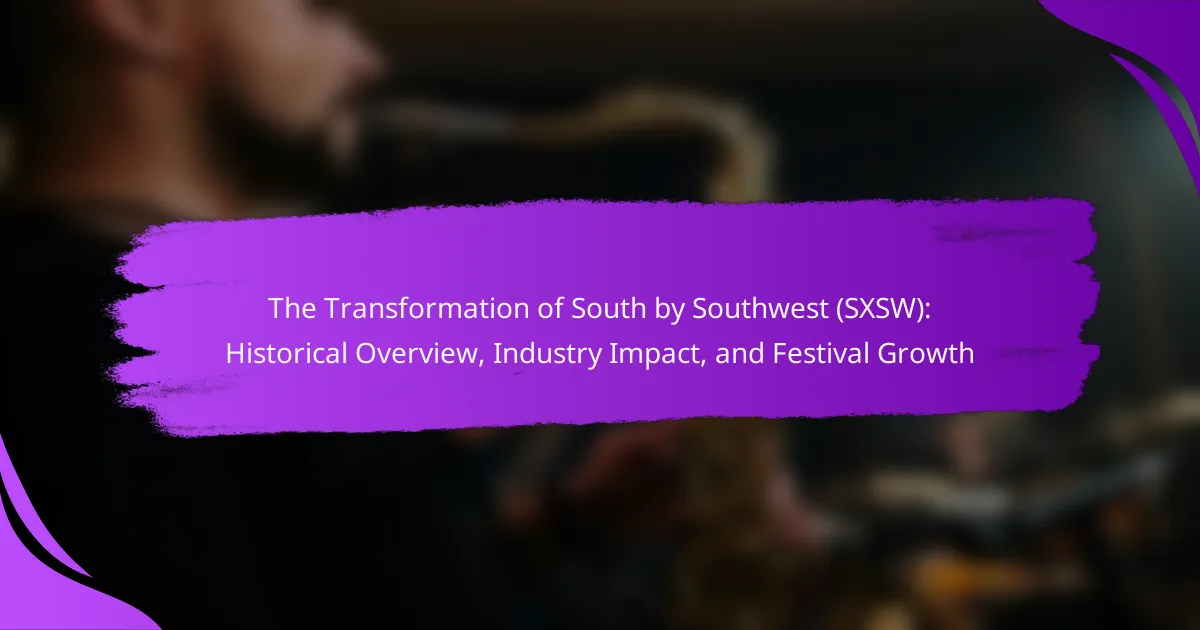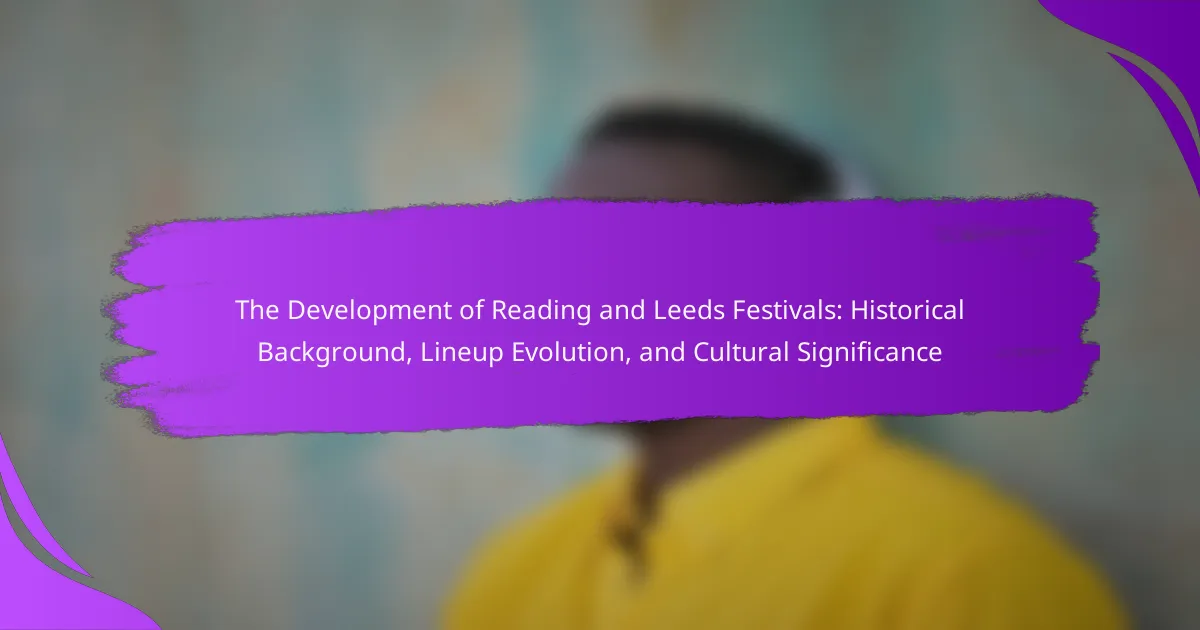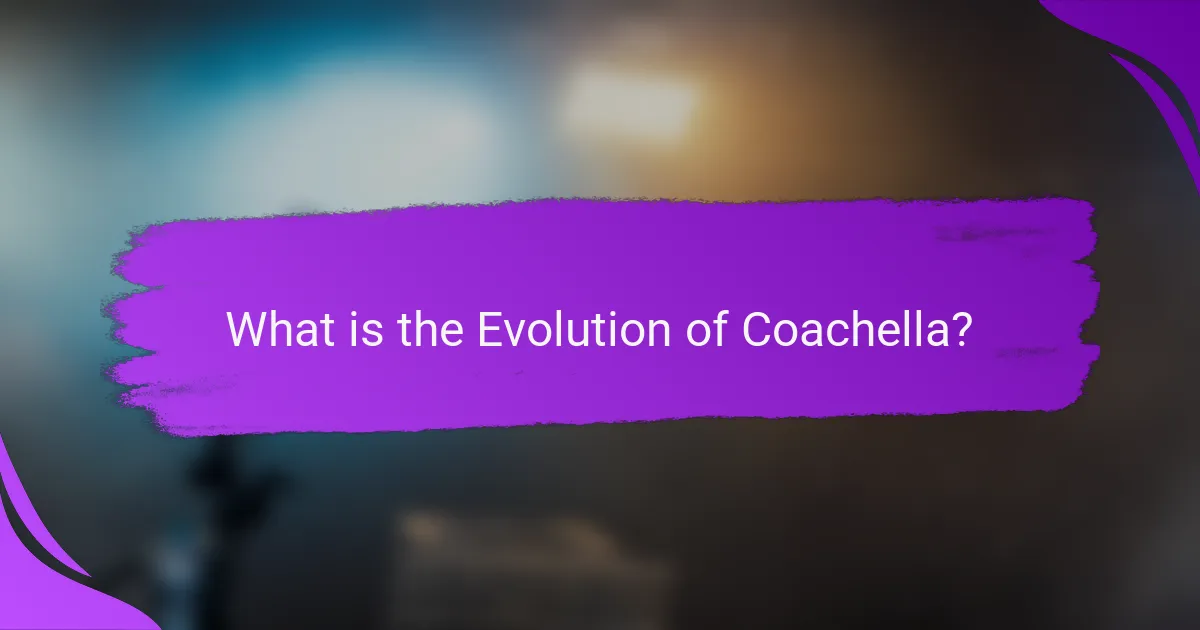
What is the Evolution of Coachella?
Coachella is an annual music and arts festival established in 1999 in Indio, California. The festival was founded by Paul Tollett and Rick Van Santen. Initially, it featured a lineup focused on alternative rock and electronic music. Over the years, Coachella expanded its genre diversity to include hip-hop, pop, and indie music. The festival’s growth in popularity led to increased attendance, reaching over 250,000 attendees in recent years. Notable changes include the introduction of a second weekend in 2012, allowing more fans to experience the event. Coachella has also become known for its art installations and fashion trends. Its evolution reflects broader shifts in music culture and audience preferences.
How did Coachella start and what were its founding principles?
Coachella started in 1999 as a music festival in Indio, California. The festival was founded by Paul Tollett and Rick Van Santen of Goldenvoice. Its primary principle was to create a diverse platform for various music genres. Coachella aimed to promote both established and emerging artists. The festival emphasized a unique and immersive experience for attendees. It also sought to foster a sense of community among music lovers. The inaugural event featured artists like Beck and Rage Against the Machine. Over the years, Coachella has evolved into a cultural phenomenon, maintaining its foundational principles of diversity and community engagement.
Who were the key figures behind Coachella’s inception?
The key figures behind Coachella’s inception are Paul Tollett and Rick Van Santen. Paul Tollett is the co-founder of Goldenvoice, the company that produces the festival. Rick Van Santen was instrumental in the festival’s early planning and execution. They envisioned a festival that would showcase diverse music genres and create a unique experience. Their collaboration began in the late 1990s. Coachella first took place in October 1999. The event was held at the Empire Polo Club in Indio, California. Tollett and Van Santen’s innovative approach set the foundation for what Coachella would become.
What challenges did Coachella face during its early years?
Coachella faced significant challenges during its early years. The inaugural festival in 1999 suffered from low attendance, with only about 25,000 people showing up. This was far below expectations, which impacted its financial viability. Additionally, the festival struggled with logistical issues, including inadequate infrastructure and poor weather conditions. In 2000, the festival was canceled due to these ongoing challenges and lack of funding. The organizers had to rethink their approach to attract a larger audience and secure sponsorships. By 2001, Coachella was successfully relaunched, addressing previous issues and establishing itself as a major music festival.
What significant changes has Coachella undergone over the years?
Coachella has undergone significant changes since its inception in 1999. Initially, it featured a small lineup of alternative rock and electronic music. Over the years, it expanded to include a diverse range of genres, attracting mainstream artists. The festival’s duration increased from one day to three days in 2001. Attendance has also grown dramatically, from approximately 25,000 in 1999 to over 125,000 in recent years. The venue has seen improvements in infrastructure, including enhanced stages and VIP areas. Coachella has also embraced art installations and immersive experiences, becoming a cultural phenomenon. The introduction of live streaming in 2011 allowed global audiences to participate virtually. These changes have solidified Coachella’s status as a premier music festival worldwide.
How has the festival’s location impacted its growth?
The festival’s location in Indio, California, has significantly influenced its growth. The desert climate provides a unique atmosphere, attracting attendees seeking a distinctive experience. Proximity to major cities like Los Angeles and San Diego facilitates easy access for a large audience. The scenic backdrop enhances the festival’s appeal, promoting social media sharing and word-of-mouth marketing. Additionally, the location allows for expansive grounds, accommodating large crowds and diverse stages. The region’s established infrastructure supports logistics, including accommodations and transportation. These factors combined have contributed to Coachella’s status as a premier music festival.
What notable lineup changes have occurred since its founding?
Coachella has experienced significant lineup changes since its founding in 1999. In its inaugural year, the festival featured acts like Beck, Tool, and the Chemical Brothers. Over the years, notable headliners have included Radiohead in 2004, Prince in 2008, and Beyoncé in 2018. The festival has also seen the addition of diverse genres, showcasing artists like Lady Gaga and Kendrick Lamar. In 2020, the festival was canceled due to the COVID-19 pandemic, leading to changes in the anticipated lineup for subsequent years. The 2022 lineup highlighted artists like Harry Styles, Billie Eilish, and The Weeknd. These changes reflect Coachella’s evolution in musical diversity and popularity.
Why is Coachella considered a cultural phenomenon?
Coachella is considered a cultural phenomenon due to its significant impact on music and arts. The festival showcases a diverse lineup of artists across various genres, attracting millions of attendees annually. It influences fashion trends, with attendees often wearing distinctive styles that become popular. Coachella also serves as a platform for social movements and cultural conversations. Its unique desert setting enhances the overall experience, creating a memorable atmosphere. The event has evolved since its inception in 1999, expanding its reach and significance in popular culture. Major brands and sponsors increasingly participate, further embedding Coachella in the cultural landscape. These elements collectively contribute to its status as a cultural phenomenon.
What role does Coachella play in the music industry?
Coachella plays a significant role in the music industry as a premier festival that showcases diverse artists and genres. It serves as a platform for both established and emerging musicians. The festival influences trends in music, fashion, and culture. Coachella’s lineup often includes headliners who are pivotal in shaping the music landscape. The event attracts a global audience, boosting artists’ visibility and career trajectories. It has become a launching pad for new talent, often leading to record deals and increased streaming. Coachella also drives economic impact in the region, generating millions in revenue. The festival’s innovative marketing strategies set benchmarks for the industry.
How has Coachella influenced festival culture worldwide?
Coachella has significantly influenced festival culture worldwide by setting trends in music, fashion, and event organization. It pioneered the multi-genre festival model, attracting diverse audiences. This model has been replicated globally, inspiring events like Lollapalooza and Glastonbury. Coachella’s emphasis on experiential marketing has reshaped how festivals engage attendees. The festival introduced elaborate art installations and immersive experiences, which are now common at festivals worldwide. Additionally, Coachella’s live streaming has popularized virtual attendance, allowing global access to performances. Its fashion influence has led to the rise of festival fashion trends, impacting youth culture. Overall, Coachella has become a benchmark for festival innovation and cultural impact.
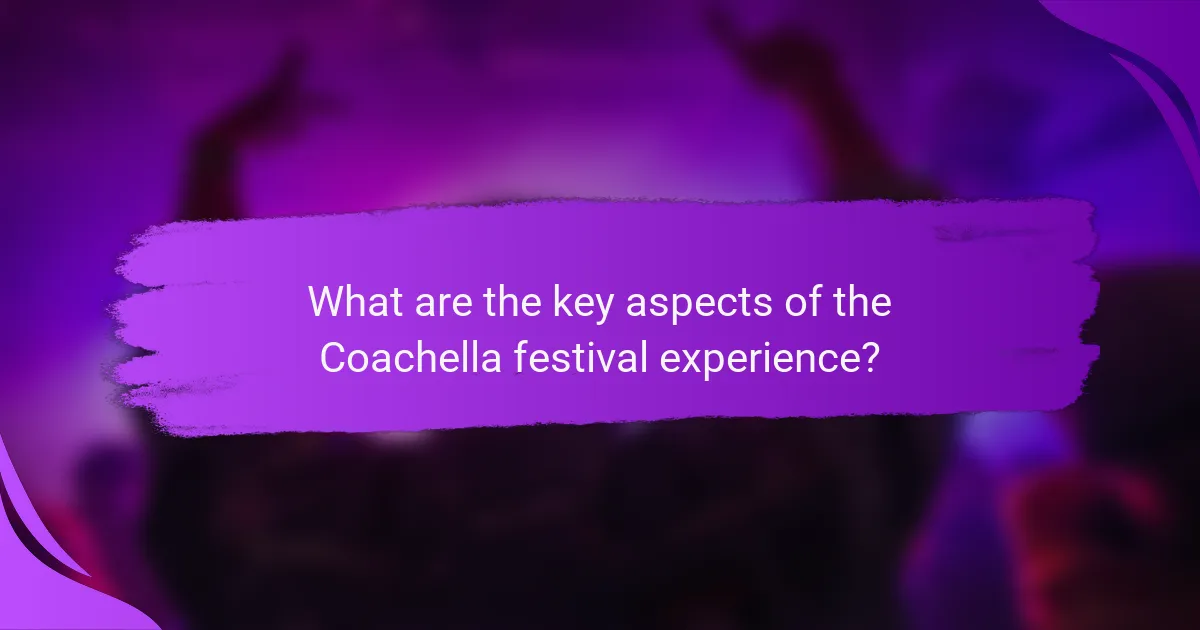
What are the key aspects of the Coachella festival experience?
The key aspects of the Coachella festival experience include diverse music performances, art installations, and a vibrant social atmosphere. Coachella features multiple stages with a wide range of artists across genres. The festival attracts over 250,000 attendees each year, creating a unique communal vibe. Art installations enhance the visual experience, often featuring large-scale sculptures and interactive exhibits. Fashion plays a significant role, with attendees showcasing creative and eclectic styles. The festival also emphasizes sustainability, implementing eco-friendly practices. Food options are diverse, with gourmet choices available from various cuisines. Overall, Coachella offers a multi-sensory experience that combines music, art, and culture.
How do attendees experience the festival atmosphere?
Attendees experience the festival atmosphere as vibrant and immersive. The setting features a blend of music, art, and community engagement. Live performances from various artists create an energetic environment. Attendees often participate in interactive art installations. The diverse lineup caters to multiple musical tastes, enhancing enjoyment. Food vendors offer a wide range of culinary options, adding to the sensory experience. Social interactions among attendees foster a sense of belonging. The overall atmosphere is characterized by excitement and creativity, making it memorable for participants.
What amenities and activities are available for festival-goers?
Festival-goers at Coachella have access to a variety of amenities and activities. These include multiple stages featuring diverse musical performances. Attendees can enjoy art installations scattered throughout the venue. Food vendors offer a wide range of culinary options, catering to various dietary preferences. There are also areas for relaxation, such as shaded lounges and hammocks. Festival-goers can participate in wellness activities like yoga and meditation sessions. Merchandising booths provide festival-themed apparel and accessories. Charging stations are available for electronic devices. These amenities enhance the overall festival experience, making it enjoyable and comfortable for attendees.
How does the festival’s layout enhance the attendee experience?
The festival’s layout enhances the attendee experience by facilitating easy navigation and access to various attractions. This design includes strategically placed stages, food vendors, and rest areas. Attendees can move fluidly between performances without missing key acts. The layout also encourages social interaction among festival-goers. Open spaces promote gathering and engagement with art installations. Clear signage aids in guiding attendees through the festival grounds. Additionally, the arrangement supports diverse activities, catering to different interests. Overall, the thoughtful layout significantly contributes to a memorable and enjoyable festival experience.
What types of performances can attendees expect at Coachella?
Attendees at Coachella can expect a diverse range of performances. The festival features live music from various genres including rock, pop, hip-hop, and electronic dance music. Major headliners often include well-known artists and bands. Emerging artists also get the opportunity to showcase their talents on smaller stages. Additionally, Coachella includes art installations and immersive experiences that complement the performances. The festival is known for its unique collaborations and surprise guest appearances. Each year, the lineup reflects current musical trends and cultural movements. Coachella has hosted iconic performances since its inception in 1999, making it a significant event in the music industry.
How does Coachella curate its lineup each year?
Coachella curates its lineup each year through a combination of artist popularity, genre diversity, and emerging talent. The festival organizers research current music trends and audience preferences. They seek to balance well-known headliners with up-and-coming artists. This approach attracts a wide range of attendees. Coachella aims to create a unique experience by including various musical genres. The selection process involves significant input from talent buyers and industry insiders. This strategy has evolved since the festival’s inception in 1999. It has contributed to Coachella’s reputation as a leading music festival globally.
What genres are most commonly represented at the festival?
The most commonly represented genres at the festival are rock, pop, hip-hop, and electronic dance music. Rock music has been a staple since the festival’s inception in 1999. Pop artists frequently headline, attracting large audiences. Hip-hop has gained significant representation in recent years, showcasing diverse talent. Electronic dance music has also become a prominent genre, reflecting current trends. The festival’s lineup often includes a mix of established and emerging artists across these genres. This variety contributes to the festival’s broad appeal and cultural significance.
What innovations have shaped the Coachella experience in recent years?
Recent innovations have significantly enhanced the Coachella experience. The introduction of cashless payment systems has streamlined transactions for attendees. This technology reduces wait times and enhances convenience. Additionally, augmented reality features have created immersive experiences for festival-goers. These features allow fans to interact with art installations and performances in unique ways. Sustainability initiatives have also transformed the festival. Coachella has increased its use of solar power and eco-friendly materials. These efforts aim to reduce its environmental impact. Furthermore, improved mobile app functionalities provide real-time updates and personalized schedules. These innovations collectively elevate the overall festival experience.
How has technology transformed the way attendees engage with the festival?
Technology has significantly transformed attendee engagement at festivals like Coachella. Mobile apps provide real-time updates on schedules and artist performances. Attendees can use these apps to create personalized itineraries. Social media platforms enhance interaction by allowing attendees to share experiences instantly. Live streaming technology enables remote participation for those unable to attend in person. Virtual reality experiences offer immersive ways to engage with performances. RFID wristbands streamline entry and enhance security for attendees. Data analytics help organizers understand attendee preferences and improve future events. Overall, technology has made festival experiences more personalized and connected.
What sustainable practices has Coachella implemented to enhance the experience?
Coachella has implemented several sustainable practices to enhance the festival experience. These practices include a comprehensive recycling and composting program. The festival encourages attendees to use reusable water bottles by providing free refill stations throughout the venue. Coachella also partners with local organizations to promote carpooling and reduce carbon emissions. The use of solar panels to power stages and facilities is another notable initiative. Additionally, the festival has introduced eco-friendly merchandise options. These efforts contribute to a reduced environmental footprint while enhancing attendee engagement and awareness.
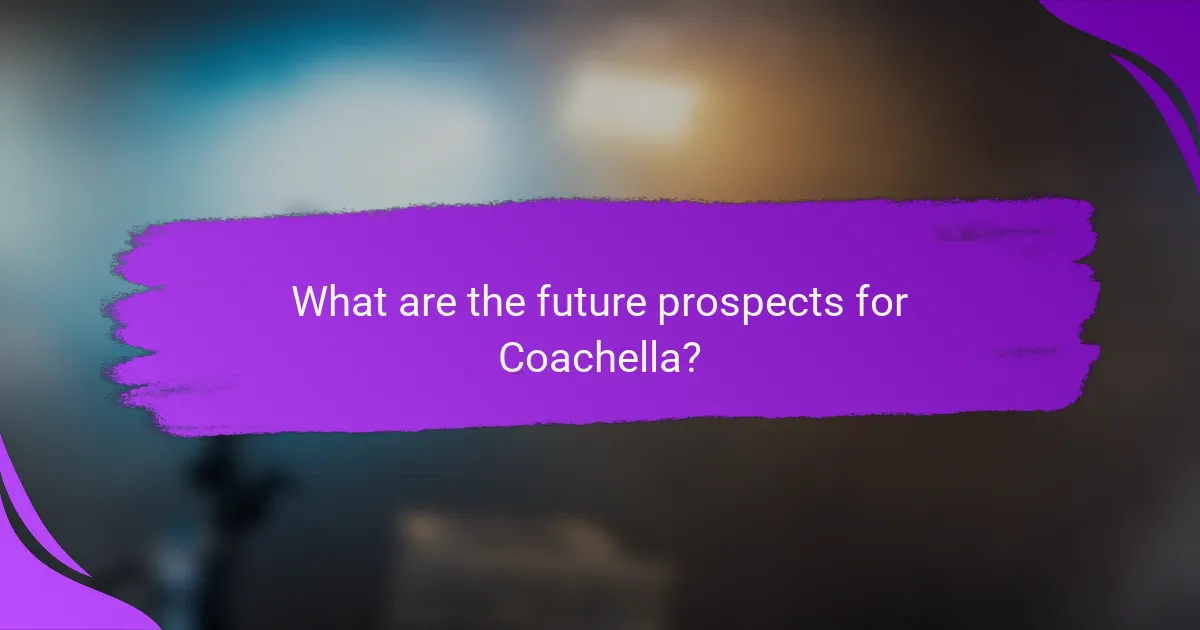
What are the future prospects for Coachella?
Coachella’s future prospects appear promising due to its established brand and loyal audience. The festival has consistently attracted top-tier artists and diverse lineups. Attendance figures have shown steady growth, reaching over 250,000 attendees in recent years. Additionally, Coachella has expanded its digital presence through live streaming and social media engagement. This adaptation helps reach a global audience beyond the physical event. The festival’s commitment to sustainability and inclusivity also aligns with current cultural trends. Furthermore, partnerships with major brands enhance its financial stability. Overall, Coachella is well-positioned for continued success in the evolving festival landscape.
How might Coachella evolve in the coming years?
Coachella may evolve by incorporating more diverse musical genres and artists. This shift could attract a wider audience. The festival has already begun featuring various genres beyond rock and pop. For instance, recent lineups included hip-hop, electronic, and indie artists. Additionally, Coachella might enhance its sustainability efforts. The festival has implemented eco-friendly practices in previous years. This includes waste reduction and renewable energy initiatives. Moreover, advancements in technology could improve the festival experience. Virtual reality and augmented reality may offer new ways to engage attendees. Overall, Coachella’s evolution will likely reflect changing music trends and audience preferences.
What trends in music festivals could influence Coachella’s future?
Sustainability and eco-friendliness are key trends influencing music festivals, including Coachella. Many festivals are adopting green practices to reduce their environmental impact. For example, initiatives like waste reduction, renewable energy use, and eco-friendly transportation are becoming standard. Additionally, diversity and inclusion in lineups are gaining importance. Festivals are prioritizing diverse artists and genres to attract broader audiences. Another trend is the integration of technology, such as virtual reality experiences and cashless payment systems. These innovations enhance attendee engagement and streamline operations. Moreover, personalized experiences and wellness offerings are rising in popularity. Festivals are incorporating wellness activities, such as yoga and meditation, to enhance the attendee experience. These trends collectively shape the future direction of Coachella and similar festivals.
How will changing audience expectations shape the festival’s direction?
Changing audience expectations will significantly shape the festival’s direction. Festivals must adapt to the evolving preferences of attendees. For instance, increased demand for sustainability influences operational practices. Many festivals are now prioritizing eco-friendly initiatives. Additionally, audiences seek diverse lineups that reflect broader cultural trends. This has led to more inclusive programming at events like Coachella. Furthermore, technology integration enhances the festival experience, with virtual options becoming essential. Data shows that 70% of festival-goers value digital engagement. Thus, addressing these expectations is crucial for maintaining relevance and attracting attendees.
What tips can attendees follow to enhance their Coachella experience?
Arrive early to secure a good spot for performances. This allows attendees to enjoy the atmosphere and discover new artists. Stay hydrated by drinking plenty of water throughout the day. Coachella’s desert climate can lead to dehydration quickly. Wear comfortable shoes for walking and standing for long periods. The festival grounds are expansive, requiring a lot of movement. Explore different stages and art installations to fully experience the festival’s offerings. Engaging with the diverse activities enhances overall enjoyment. Use the festival app for real-time updates on set times and location changes. This helps attendees plan their schedule efficiently. Lastly, connect with fellow festival-goers to share experiences and recommendations. Building a community enriches the Coachella experience.
How can festival-goers prepare for their visit to Coachella?
Festival-goers can prepare for their visit to Coachella by planning their accommodations and transportation in advance. Many attendees book hotels or campsites months prior due to high demand. It is essential to review the festival lineup and schedule to prioritize performances. Creating a daily itinerary helps manage time efficiently. Staying hydrated and packing sunscreen are crucial for comfort in the desert climate. Festival-goers should also bring portable chargers for their devices. Familiarizing themselves with the festival grounds layout aids in navigating the venue. Lastly, checking the festival’s official website for updates ensures awareness of any changes or important announcements.
What are the best practices for navigating the festival grounds?
To navigate the festival grounds effectively, attendees should plan their routes in advance. Familiarize yourself with the festival map before arrival. Identify key locations such as stages, restrooms, and food vendors. Arrive early to avoid crowds and secure a good viewing spot. Stay hydrated and take breaks to manage fatigue. Use designated pathways to maintain safety and avoid congestion. Keep an eye on the schedule for performance times and locations. Utilize mobile apps for real-time updates on set times and changes. These practices enhance the overall festival experience and ensure safety and enjoyment.
The main entity of the article is Coachella, an annual music and arts festival that began in 1999 in Indio, California. The article provides a comprehensive overview of Coachella’s evolution, detailing its founding principles, significant lineup changes, and the overall festival experience. It highlights key figures behind its inception, challenges faced in its early years, and how the festival has become a cultural phenomenon. Additionally, the piece discusses the impact of location, innovations in technology, sustainability efforts, and future prospects, offering insights into how Coachella continues to shape and reflect trends in the music industry and festival culture.
